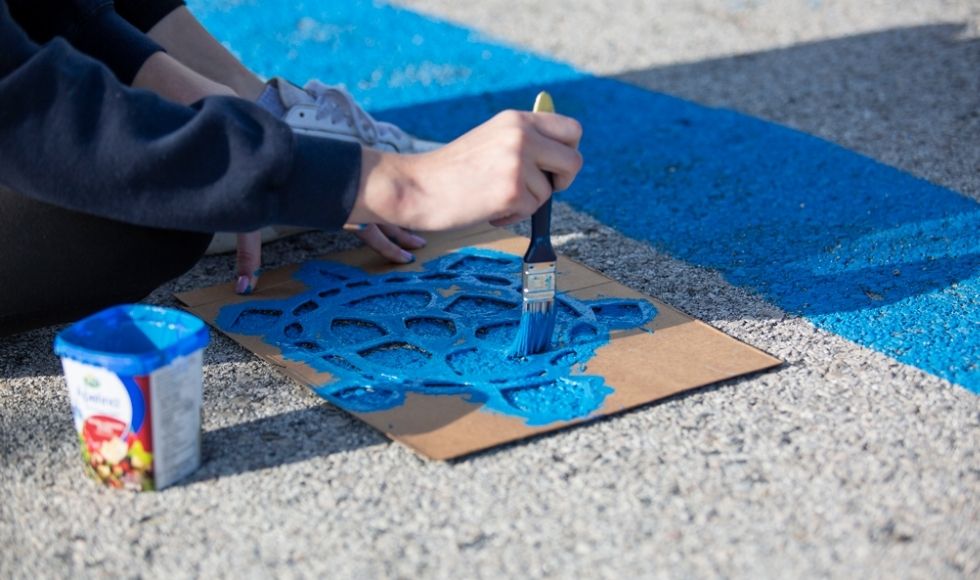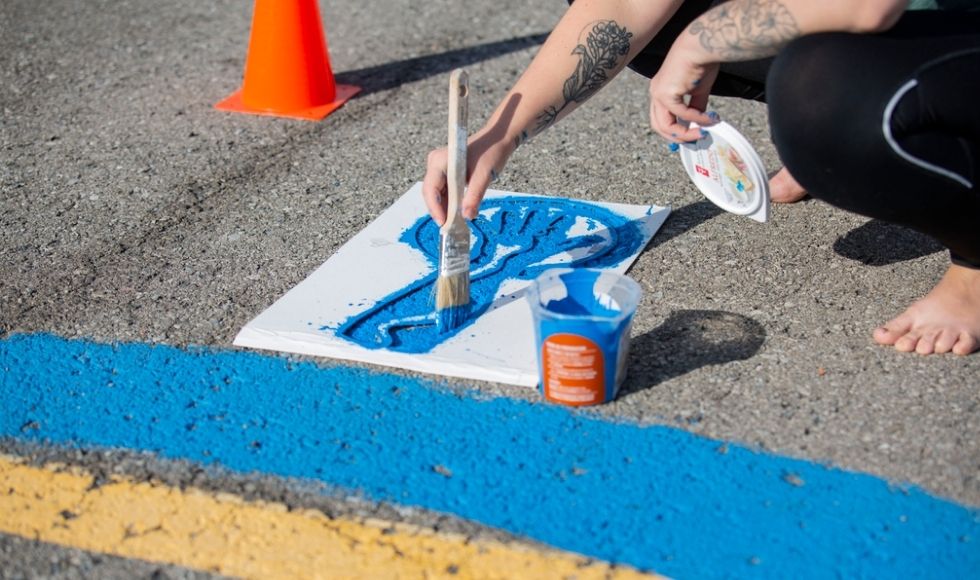Finding the flow: McMaster begins to reimagine west campus parking lot with art installation

The West Campus Eco-Art project reimagines Parking Lot M with stencilled art of key species of flora, fauna, historic symbols, all painted along blue lines that represent the former routes of Coldwater Creek. (Photos by Colin Czerneda, Faculty of Humanities)
This week, students from McMaster’s School of the Arts wielded their paintbrushes on a different kind of canvas: asphalt. Their assignment — to paint nature and reimagine a parking lot — is part of the West Campus Redesign Initiative (Watershed Trust), a university-wide collaboration aimed at reclaiming the ecologically sensitive wetland located near parking lot M.
“We’re working together to green our west campus and replace our parking lot with a mosaic of wetlands at McMaster University, but there’s still a lot of planning and work ahead,” said Judy Major-Girardin, a professor in the School of Arts and one of the leads on the project.
“The West Campus Eco-Art project is a way to activate the site immediately.”
McMaster’s parking lot M sits in the centre of the Coldwater Creek valley, the nexus of a large natural corridor connecting the Royal Botanical Gardens to the north and the Dundas Conservation area and escarpment to the south. The creek runs alongside the parking lot, which was built in 1968, but research has revealed that the water took multiple routes through the floodplain over the last century.
“We want to mark some of that history by painting lines on the asphalt along the old routes that the creek used to take and mark that history on the asphalt,” said Major-Girardin.
Her students created stencils of key species of flora, fauna, historic symbols or text and arrived in small cohorts on Sept. 20 to paint their own creations along the blue line.
The initiative is a way to provide students and community members with a visual experience that can deepen their knowledge with a place and its social history, science, ecology and diversity.
Hannah Essex, a third-year studio art student, participated in the project both as an artist and as a volunteer. For her, the exercise was a way to remember the history of the area and to imagine what the West Campus Redesign Initiative could ultimately achieve.

Essex modelled her stencil after the northern water snake, which is a species the Watershed Trust hopes to introduce into the wetland once it is restored.
The details of her stencil included an outstretched hand, a northern water snake, and a halo.
“I wanted to disrupt the Christian narrative of the snake as evil and welcome it back into the settler narrative as a precious thing,” she said. “It felt like a really hopeful experience.”
“We’ve had data about the natural environment for decades, but data doesn’t always inspire people to change,” said Major-Girardin.
“I think art has a really important role in reaching all of those people who are not scientists. It gives them something experiential, something visual. They see a blue line running through the parking lot and they think, ‘Oh yeah, water used to move through this area.’”
The West Campus Eco-Art Project is a collaboration between the School of Arts, Nature @McMaster and the McMaster Museum of Art. The project is ongoing, and community members will also have an opportunity to participate at a future date.


